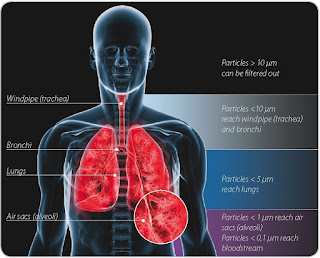AIRBORNE HAZARDS ARE ALL AROUND US
Whether it's occupational, by choice, or a matter of circumstance from the environment we live in, we are all exposed to airborne hazards daily. Some may be more detrimental to our health than others, but it is pose for concern and discussion as to how dangerous this hazards really are and by what mechanisms they impact our health. Various factors that will be discussed are: 1) how the size of the containment impacts our bodies, 2) the locations of the respiratory tract infected, and 3) the mechanisms in which our bodies attempt to cleanse or rid the hazards. There are state and federal regulations that protect us all and provide us the rights to work in a safe and hazard free environment!
AIRBORNE HAZARDOUS MATERIALS BY SIZE
There are five major airborne hazard categories that are classified by size. They are as follows:
- Vapors (gaseous phase of liquids)
- Dust (aerosals composed of dry particles)
- Gases (most common airborne contaminate)
- Fumes (materials heated to a point where they become a gas)
- Mists (airborne droplets)
REGIONS OF RESPIRATORY TRACT
Regions of the respiratory tract all influence various different components of our air quality and the hazards that are encompassed within them. The regions are: inhalable fraction (known as the nasopharyngeal region (NP); thoracic fraction (known as the tracheobronchial region (TB); and the respirable fraction (known as the pulmonary region). Our nasopharyngeal region is essentially the region that intakes almost 100% of all of our environmental air and along with it, potential hazards. Where the contaminants travel down to, is dependent upon the size and other factors.
MUCOCILIARY ELEVATOR
The mucociliary elevator is an internal mechanism within the respiratory tract, that acts as a protection barrier from foreign invaders. The thick sticky mucous lining traps pathogens and other particles inhaled and the cilia move in a rhythmic fashion to expel the contaminates out of the body. This process is constant and involuntary. Cilia projections are continuously moving and beating.
RESTRICTIVE VERSUS OBSTRUCTIVE LUNG IMPAIRMENT
Restrictive impairment within the lungs refers to a reduction with the air volume. It influences how much air can be inhaled and exhaled. An example of this could be hardening of the muscles surrounding the outside of the lungs that become rigid and less flexible. Obstructive lung impairment however, involved the small airways (or bronchioles) and damage to those entry ways. The lung volume (vital capacity) itself has not been altered, it is the airways that are obstructed or impaired. A very common example of this is individuals who suffer from asthma.
In many of the pictures depicted above, there are example of military personnel or Veteran Affairs initiatives involved open burn pits and airborne hazards. This is just one major example in our society where men and women each day have risked their lives and continue to, in harsh, dangerous, and lethal environmental conditions. Often times, we advocate for some of the major hurdles in our paths that are often the one's seen. However, airborne hazards are usually invisible and taken for granted daily and they may in turn, be the most deadly.








